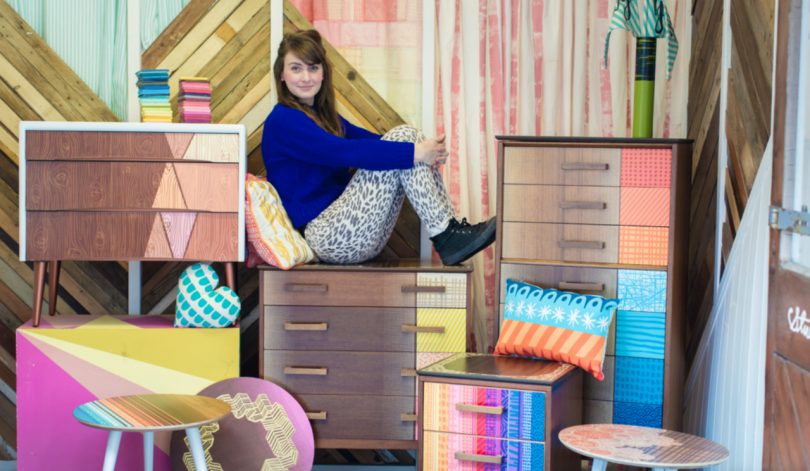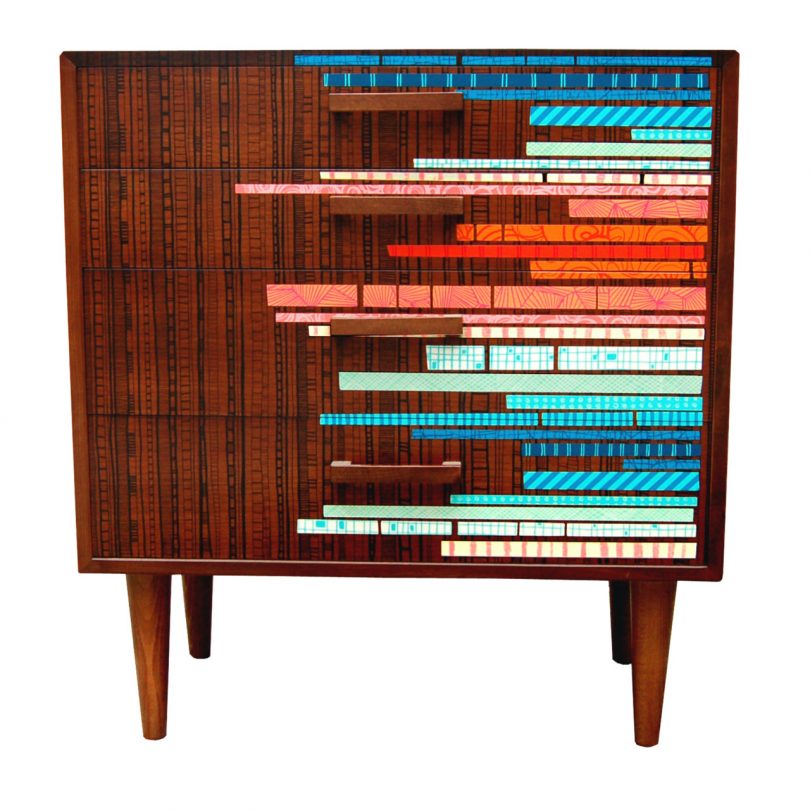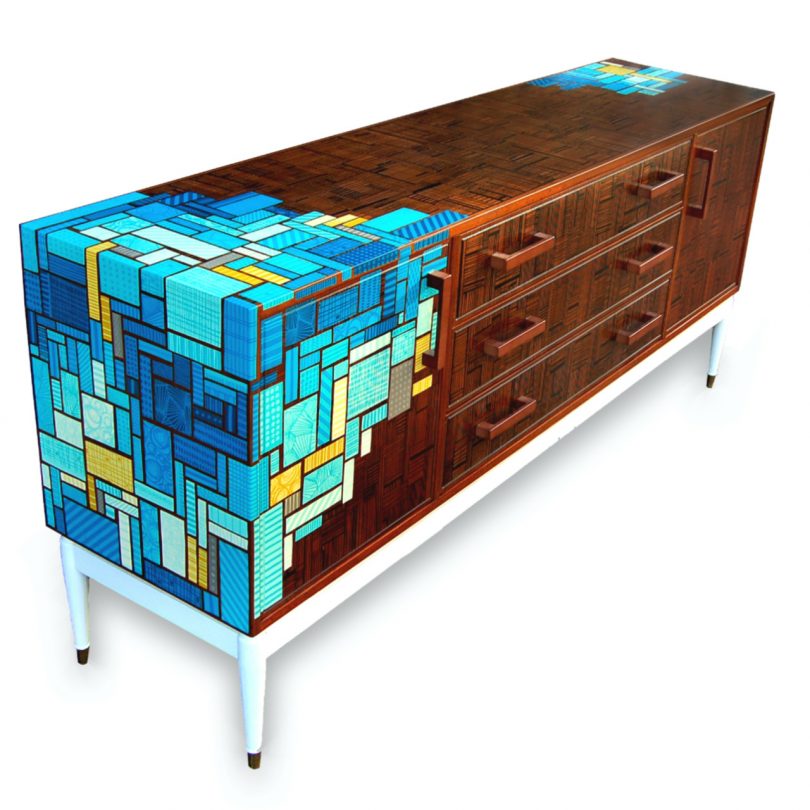Circular by Design , a fortnightly column by longtime contributor Katie Treggiden, explores the reuse of waste as a way to keep materials in use and bring the legacy of the linear system full circle.
British designer Zoe Murphy champions the notion of ‘loving what belongs to you’ by printing onto recycled furniture and textiles using imagery inspired by the faded glory of her seaside hometown of Margate, Kent, on the south coast of England. Zoe graduated from Loughborough University in 2008 with a first-class honors degree in printed textiles. Having always been fascinated by the potential of re-use and rejuvenation of unwanted items, she works closely with the idea of encouraging others to consume with more care.
Tell me a little bit about your childhood, education and background in terms of how you first became interested in creativity, design and sustainability.
I was born and raised in Margate. Both of my parents were school teachers and so we always had a lot of educational textbooks around the house and I seemed to be preoccupied with spending summers learning things from the books and then re-drawing the pictures and text from them into sketchbooks of my own. I was reproducing these little graphic interpretations when I picked up a book all about the environment and the ozone layer. I was so shocked to read about pollution, that I wrote to the Queen about it. (This is not a joke, my parents didn’t know I had done it until I received a reply from a lady-in-waiting at the palace!) I resolved, there and then, to do more to spread the message that I’d read. It seemed really important to me, and my tiny developing mind decided that I could get more people to pay attention if I could translate the information out of that dusty textbook using my own unique skills and talents. I went on to study textile design and screen printing at university, but always retained a strong sense of duty and have therefore always strived to create things that spread awareness about the environment and waste.
How would you describe your furniture?
I screen-print my own hand-drawn designs and patterns onto second-hand wooden furniture and create cheerful, graphic and very colorful furniture pieces such as chests of drawers, tables and sideboards. The storage and surfaces that I create with objects others have discarded have a very mid-century look to them before I apply a lot of pattern and decoration. This is a conscious choice for me as the interiors from that period have very simple and straight or smooth forms and so they support my details and statement print work in a way that doesn’t make a piece feel too busy in the end. My designs have their roots in the time I spent studying to be a textile designer and growing up in Margate. For that reason, I always seem to have a lot of suns, flowers, sunrays, happy shapes and optimistic imagery. It matters to me to make something positive out of the waste I’m using and I know that can be engineered on every level, so even the colors I choose will have a warm and bright feel to them. First and foremost, I want people to feel good when they look at my work, and perhaps only after that discover that it is reused.
What inspired this project?
I like to investigate new design ideas every few months and they are always born from an interest or compulsion that I’m exploring at the time. My latest collection of work has been inspired by one of my design heroes Vera Neumann who was a silk scarf designer in the 1950s. She began life as a painter so when the war finished and parachute silk was an abundant material she began painting her work onto silk instead. Vera would still sign all of her designs, even when they were silk scarves instead of paintings, and is known for popularizing the idea of a ‘signature’ scarf. I was so inspired and impressed by an artist using her creativity in such a practical way but also retaining the value of her artistic identity at the same time, for me it felt an important blend of the two disciplines – art and design. Particularly at a time when a lot of creatives are feeling pressed to make-do and the world is in a state of flux and uncertainty, it’s encouraging to think that even after a great war or shortage of materials it’s possible to pivot and emerge with tenacity and flair. The sets that I’m making for the collection all come from one huge oak table that had a split from age and was heading to the tip. It’s fruited a batch of screen-printed coffee tables and matching candlesticks that celebrate the idea of looking again even in the most difficult of eras.
What waste (and other) materials are you using, how did you select those particular materials and how do you source them?
I work exclusively with unwanted and badly damaged wooden furniture, often solid woods but mostly pieces that have been veneered. Although these will have been cheaper to produce in their time and are sometimes more stable than solid wooden pieces, they are nearly always chipped, ripped, stained or broken because of how fragile veneers and the light wood furniture frames are over time. I try to get pieces that are badly damaged, that are about to be thrown away, or that need a lot of repairs. If it’s stylistically out of date too that is a bonus, because of the way that I work I can bring furniture into different centuries and make things look a lot more contemporary. I’m mostly given or find unwanted furniture, it’s still surprising how much people leave on roadsides and throw away – my most recent collection was made from a table that was about to be thrown into a chipper at a recycling centre.
When did you first become interested in using waste as raw material and what motivated this decision?
I was campaigning and caring for climate change from a young age, and wrote my university dissertation on consumption patterns and how to steer them in a market to make for more sustainable activity. In 2008, when I was challenged with creating my degree show (to showcase my print work) I knew I wanted the entire collection to be reused and made from waste. That’s when I started screen printing onto wood and furniture and even wedding dress silk for soft furnishings – eventually my entire show was made from waste.
What processes do the materials have to undergo to become the finished product?
I start by carefully removing and dismantling a piece that I’ve chosen to use, stripping the existing lacquer, unscrewing all of the components and restoring anything I hope to use again. I will remodel most of my furniture pieces by adding new legs, handles and sometimes splitting the piece into different sized units to get the maximum use out of the material. It feels very important to me that all of the forms look like they have come from the same place even if they start out looking very different. Unwanted furniture as a waste material has a better chance if I am able to pull it in to a recognized aesthetic that people trust and value and that I’ve worked hard to brand. So I strip back a unit to its most simple form and then prime it for printing. Once I have designed something I’m happy with, the silk screens are used to apply layers and layers of print work onto only certain parts of a piece. This means being able to choose parts that are very badly damaged to cover with the pattern and leaving the rest of the remaining wood to be celebrated. When the print is applied, all parts are revarnished and then reassembled with any new wooden components added (these are made by a woodturner local to me). The final touches are to line or fabric the inside of any storage units to make sure that every part of a piece feels exciting and special to discover. And then, much like Vera, I sign my creation!
What happens to your products at the end of their life – can they go back into the circular economy?
Because I know that every time wood is stripped or painted it takes a little more of the material away and reduces its possibilities for the next time it might be recycled, it’s always my aim to decorate and print onto as little of a piece as possible while still moving it on enough to be found refreshing for a consumer. Everything is screwed together, printed with water-based paints, and lacquered with a durable varnish, so that it will last for as long as possible and then finally will have enough original material for it to be reused again. It takes an incredible amount of time and care to reuse waste and I’m of the opinion that the application of craftsmanship can elevate any material. I use my researched and designed print work to add value and rescue a material that isn’t considered useful. I aim to deliver an emotional connection and delight to the people who buy my work, so that they will care for it properly and keep it for longer than the average piece of furniture.
How did you feel the first time you saw the transformation from waste material to product/prototype?
It would have been at a very very small age. My favorite thing to do as a little girl was to make dresses for my Barbies and furniture for my doll house. None of them were made from things I had bought because the thought didn’t even occur to me – why would I use new things when there was so much already available? I clearly remember making a set of living room chairs for my doll house, padded and upholstered, from toilet rolls. The buzz I got from taking something that really was the lowliest material and fit for the bin and turning it into something so useful and domestic, was unmatched. Giving things a second chance at being valuable made me feel valuable, and that feeling hasn’t ever gone away.
How have people reacted to this project?
The response to my work from others has always been an emotional one. I imagine it comes from the narrative created when you see pictures and drawings on things that often are just a color or a surface. I make work to express how I feel and what I care about, so it can still be a surprise for me how much people emotionally invest in the things that I make. It nearly always makes people smile or exclaim something, and the extra benefit is when they find out that it’s made from something that was ready to be thrown away. The polarity of that is always special and memorable for people and is likely a reason that all waste reuse has an impact beyond that which a new material on its own can generate. The legacy of a product makes it all the more interesting, as waste has lots of lives before it. I pour a lot of myself into every piece I make and thank the way that I market myself and my work for that. I talk and share a lot with the people who buy from me and I know that when they look at something I have made, see the creative as much as the creation. It’s another aspect that helps the waste I chose to reuse, as I’m determined to package myself up with the product as a way of giving the best chance of striking a light in a customer.
How do you feel opinions towards waste as a raw material are changing?
What I think is really helpful is how much awareness has grown around the issues of climate change. The primary objective is to create with better and non-toxic materials and to use up what exists already so that more doesn’t need to be produced. It’s still novel and notable to recycle instead of using raw materials in product design and I’m looking forward to a day when it’s just considered standard to look for a reusable option first before using something new. As a designer it can be more fussy and time consuming to use waste rather than buying in big predictable sheets of material, but educators and informed creatives are drawing attention to the fact that ongoing consumption is a zero-sum game. If we are going to move forward in a way that isn’t destructive for ourselves or the planet, we’re going to have to make creative accommodations, and that’s definitely something that is talked about more than it used to be.
What do you think the future holds for waste as a raw material?
As material scarcity starts to increase – either through increased demand from populations or reduction in the amount of raw materials still available – I have no doubt that we will all get more creative with our production cycles through necessity alone. It seems likely that some dramatic environmental activity will also remind consumers of what the status quo is doing to our resources as well, and so it’s likely that there will be a shift in concern that will start to hopefully move us over to using waste in production more. It will be great to see technology and connectivity play a bigger part in reallocating materials, and all the while our systems and apps develop there’s a big opportunity to use that connectivity to deliver information about resources and what is available. Imagine a time before eBay, and think how much was thrown away because we couldn’t find someone who wanted that exact item. It’s beautiful! I would love to see increased connection providing more circular solutions like this.
from WordPress https://connorrenwickblog.wordpress.com/2020/11/24/zoe-murphy-turns-unloved-furniture-wood-and-textiles-into-vibrant-home-accessories/












No comments:
Post a Comment